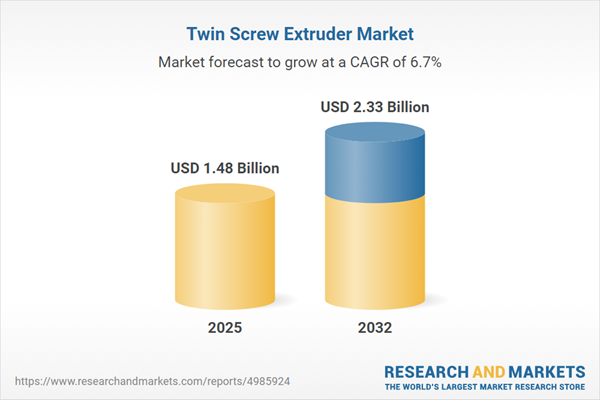Speak directly to the analyst to clarify any post sales queries you may have.
The twin screw extruder market is rapidly evolving as manufacturers and industrial leaders pursue dynamic operational intelligence and refined compliance strategies. This growing complexity demands actionable insights for senior decision-makers aiming to enhance resilience and efficiency.
Market Snapshot: Twin Screw Extruder Market Size and Growth Analysis
The global twin screw extruder market demonstrates consistent expansion, driven by ongoing technological advancements across pivotal sectors including food, pharmaceuticals, chemicals, and plastics. Market momentum is sustained by both co-rotating and counter-rotating designs, which together offer adaptability and operational reliability. As manufacturers invest in infrastructure and adapt to diverse regulatory frameworks, opportunities for market entry and growth expand, while regional strategies continue to shape demand and supply chain strength. Industry leaders improve their market positioning by responding proactively to workforce skills development and changing production requirements.
Scope & Segmentation Overview
Clear segmentation enables executive teams to adjust procurement strategies and address evolving market priorities effectively:
- Type: Co-rotating and counter-rotating extruder machines are tailored to meet various processing requirements, accommodating different throughput rates and maintaining consistent output quality.
- Application: Utilization in chemical processing, pharmaceuticals, plastics manufacturing, food production, and animal feed supports specialized technical objectives and strict compliance benchmarks.
- Equipment Size: Available options cover compact extruders for small-batch operations and high-capacity systems for industrial-scale production, helping organizations align investments with their scalability goals.
- Drive Type: Electric and hydraulic drive solutions fulfill different automation needs and energy priorities, impacting operational efficiency and future technology integration.
- Industry Vertical: Sectors like agriculture, automotive, packaging, consumer goods, and healthcare require tailored solutions due to distinct compliance standards and procurement practices.
- Regions: Adoption varies across the Americas, Europe, Asia-Pacific, Middle East, and Africa, shaped by infrastructure quality, workforce training, and the local regulatory environment.
- Leading Manufacturers: Established companies such as Coperion GmbH, The Japan Steel Works, Ltd., Leistritz AG, Bühler AG, and KraussMaffei Berstorff GmbH maintain leadership through ongoing innovation and a commitment to quality standards.
Twin Screw Extruder Market: Key Takeaways for Senior Decision-Makers
- Advanced sensors and digital twin technologies enable real-time data collection, supporting adaptive process improvements and quicker response times in manufacturing.
- Modular barrel configurations with greater automation enhance flexibility, reducing both downtime and material waste while aligning to shifting production demands.
- Strategic research and development partnerships provide access to niche markets and help streamline customized solutions for complex industrial needs.
- Extruders engineered for food and pharmaceutical applications are delivered with comprehensive compliance documentation and integrated safety controls specific to regulated sectors.
- Predictive maintenance initiatives prolong equipment life, minimize unexpected shutdowns, and support asset management goals for operational reliability.
- Robust scenario planning and supply chain risk analysis assist sector leaders in navigating volatility in global markets and maintaining consistent operations.
Tariff Impact on Supply Chains and Operations
Recent modifications in United States tariffs prompt a reassessment of sourcing models and supplier networks, particularly concerning vital materials and core components. To maintain supply chain resilience, organizations enhance collaboration with suppliers, optimize inventory workflows, and regularly refine procurement tactics. These efforts are essential to adapt to policy changes swiftly and ensure stable production outputs in fluctuating regulatory contexts.
Methodology & Data Sources
This market analysis derives from direct interviews with senior executives, feedback from technical experts, and extensive research. Utilizing a multi-source data approach supports objective benchmarking and provides reliable guidance for anticipating market shifts and future scenarios.
Why This Report Matters
- Equips senior leadership with intelligence on emerging technologies and regulatory changes, strengthening readiness for compliance and operational planning.
- Facilitates improvements in procurement and supplier engagement, enabling proactive adjustments to regional trends and market requirements.
- Supports executive decisions relating to risk management and continuity by offering strategies for meeting regulatory and supply chain challenges.
Conclusion
This report guides decision-makers in aligning operational strategy with evolving market trends, driving targeted innovation, and maintaining business relevance in a dynamic industry environment.
Additional Product Information:
- Purchase of this report includes 1 year online access with quarterly updates.
- This report can be updated on request. Please contact our Customer Experience team using the Ask a Question widget on our website.
Table of Contents
3. Executive Summary
4. Market Overview
7. Cumulative Impact of Artificial Intelligence 2025
Companies Mentioned
The companies profiled in this Twin Screw Extruder market report include:- Coperion GmbH
- The Japan Steel Works, Ltd.
- Leistritz AG
- Bühler AG
- KraussMaffei Berstorff GmbH
- Milacron LLC
- Hosokawa Micron B.V.
- Davis-Standard LLC
- Shanghai JWELL Machinery Co., Ltd.
- Nanjing Giant Extruder Co., Ltd.
Table Information
| Report Attribute | Details |
|---|---|
| No. of Pages | 184 |
| Published | November 2025 |
| Forecast Period | 2025 - 2032 |
| Estimated Market Value ( USD | $ 1.48 Billion |
| Forecasted Market Value ( USD | $ 2.33 Billion |
| Compound Annual Growth Rate | 6.6% |
| Regions Covered | Global |
| No. of Companies Mentioned | 11 |









